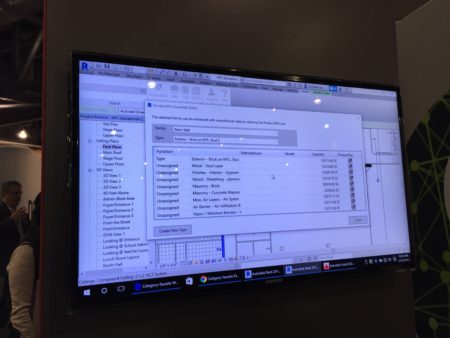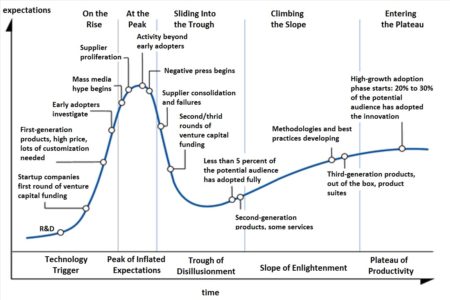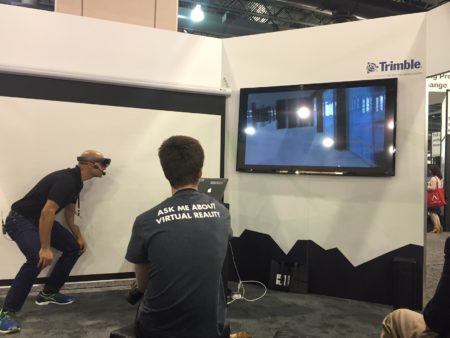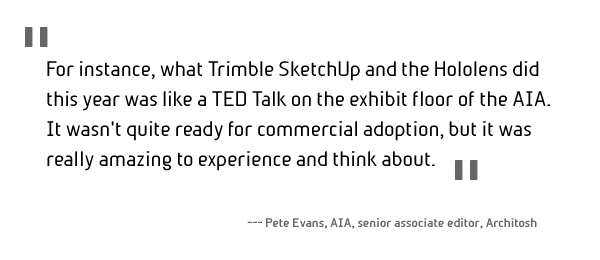A Conversation: Introduction
This year we decided to turn this “perspectives” feature on the BEST of SHOW at AIA into a conversation. We typically have an intense conversation anyway during and after the show debating merit and the various themes emerging in IT technologies for architectural practice.
This conversation not only discusses various products and technologies shown at the show and highlighted for our readers, it, more importantly, aims to provide our own activities in reviewing these technologies annually additional structure. We used the Hype Cycle as an armature about which we could position companies, their tech, and their products and services. Moreover, it served to highlight points in time (e.g.: edge of reality, edge of market) where technologies become discovered and discussed in the larger context before they are mass adopted. Dead smack in the middle of the Hype Cycle is this point where less than 5 percent of a potential audience has actually adopted a technology fully.
If we were to use the Hype Cycle—which was a concept developed by IT research firm Gartner—and frame a left side and right side analysis overlay on the technologies we saw at the show in Philly, BIM as a mainline authoring platform tool, a backbone technology in a workflow transformation, would be on the right side. BIM adoption is much more than 5 percent. However, technology like AR (augmented reality) is far left side on the chart.
In comparing all that we saw, and given the ground we have traveled, we began to see BIM maturing, in light of the reality of boots on the ground with it. This “beyond BIM” view was further reinforced by Neri Oxman’s powerful and gripping picture of the future of designing and making in our world. (watch the video below for a taste of what we saw at AIA).
Discussion
Beyond BIM
Anthony: I think this year at AIA Philly we clearly noticed a shift was underway within software and technologies in architectural practice, in fact all of AEC. BIM is no longer the center of gravity that it once was. The primary BIM authoring tools, while still advancing, have greatly matured to the point that perhaps the essence of what BIM is really about—process change—is finally making itself clear. And I think it was fitting that Neri Oxman was here in Philly to talk because her work offers a fascinating peak around the bend at where the future of making products, both tiny and massive, is headed.
More instructive still, Oxman’s talk clearly delineated the importance of four key fields that, while incredibly new, when they overlap, power the types of innovations she is interested in in the pursuit of single-material systems in lieu of assemblies of multi-material systems. Working at the intersection of computation design, additive manufacturing, materials engineering and synthetic biology, her pioneering work temps us, as architects, to imagine our roles in society in broader terms. This fit with the AIA’s “take risks” theme this year. And insofar as our editorial tasks involves highlighting new and exciting technologies shown at the AIA National, this widening lens causes one to reframe BIM differently.
Pete: Yes, it was an interesting phenomena this year to see the maturity of BIM appear almost common and the fringe of seemingly impractical issues take a front seat. Neri Oxman really seemed to be the spark taking the conversation about where the next bend in practice and research might lead. And ironically, it was the transformation of one of the old standards of practice that really brought the maturity of BIM into focus so as to see the forest for the trees.
Anthony: Yes, you are referring to what Sweets has done internally with their product vision and more importantly their technology and how they see data for them working to serve the market. What they have done, and what they are doing, should get Gen-X architects excited to finally see where the Sweets data can really belong in their workflows. And for Millennials, it should introduce a brand perhaps for the first time.
Pete: It was also a noticeable growth in the supporting technologies that have been emerging around BIM too. There was some clear culling of the field with some of the AR/VR we saw last year. What we saw this year was really doing the job well. That might have been part of the shift too where things around BIM and connecting BIM have a better place and focus now.
Edge of Reality
Anthony: Introducing the Emergent Technologies category honor this year makes sense within this context where visions like Oxman’s imagine a more profound role for the architecture field in society. I imagine in the years to come AIA conventions will play hosts to the introduction of technologies that are farther afield, pre-alpha, even visionary early experiments. I think the Autodesk Project Fractal work is in this category.
Pete: This Emergent Technologies category is a strong addition to the awards where the concepts and ideas are provocative. And it’s really important now as things continue to rapidly change and even accelerate in that change. It took a long time for the evolution or adoption of CAD to get to BIM and to where we are now. The advances in the next few years that will be taking place are important to discuss together as they will again evolve practice even more remarkable than before.
For instance, what Trimble Sketchup and the Hololens did this year was like a TED talk on the exhibit floor of the AIA. It wasn’t quite ready for commercial adoption, but it was really amazing to experience and think about. It fundamentally changes how we can interact with design—past paper and the desktop screen—which is what we have grown accustomed to in the CAD and BIM era the past 30 years, and that is going to change quickly. The profession as a whole needs to be very aware of the likely change, anticipate the possibilities and be actively involved in that transition.
Edge of Market
Pete: Continuing with the Innovation Award from last year, and with the introduction of the Emergent Award, there is a clear framework for discussion about where the provocative technologies are now impacting practice. This becomes a great way to recognize where a technology takes root and actually shifts practice orientation… something that is ready to be adopted and move practice forward. One winner from last year, CL3VER, who introduced a very unique WebGL/WebVR technology solution to architecture, was able to show a fantastic example of a client project that could be a template for more projects to develop through these innovative technologies.
Anthony: Yes, the Innovation category has some flexibility too and that is helpful. Thematically, there are several things going on in practice; we might begin to describe some of these things as pressures or stresses on the discipline or business of architecture. For example, the product design software world has already passed through the phase of rapid high-quality rendering in products like KeyShot. The goal is vastly accelerated iteration time wherein photographic rendering imagery is seen as vital to the iteration loop. This trend is finally hitting hard now in AEC. Hence, the rise in tools like Lumion and the elegant way Chaos Group is taking V-Ray technology and its famed quality and making it much faster to get those results in many other programs. What we are going to see coming up fast and furious is the recognition that a complete loop of iteration in architecture requires photo-realistic rendering. This doesn’t drastically change how practice utilizes renderings—orientation wise—but it puts pressure to squeeze this quality into the iterative loop there today and it begins to changes the nature, and for some, necessity of arch viz specialists.
What was also very edge of market or “early” is the concept of replacing our standard file systems with sophisticated CMS (content management systems) like AVAIL. Particularly where these architecture CMS systems dovetail nicely with the mainline tools architects use in their workflows—the whole idea is refreshingly innovative. What has to happen next is how AVAIL learns to work and extend out via the cloud so that such CMS systems can travel with the remote professional or deal with multiple offices.
Pete: And presented together in the booth area (2711) on the exhibit floor, these four technology companies all showed their technology solutions tied into different parts of a project workflow that complemented each other, and showed a subtle but elegant solution in combination that was more about recognizing the need to be nimble and collaborative, to help the actual project improve by removing barriers and working together. It was a neat realization on the exhibit floor of several smaller technologies looking pretty big together.
The Desktop Honor: Not Second Fiddle to the BIM Award
Anthony: Neri Oxman clearly amplifies or underlines the importance of computational design. If the AEC industry, and architects in particular, were having some second doubts (or perhaps still firsts…?) about whether computational design technologies are just a fad or going to be sticking around, Neri Oxman nailed shut any lingering doubts. What we see in her trailblazing work—and this goes to some of the things that the generative group at Autodesk is doing also—is that computational design technologies are vital—even foundational—for the future of architecture.
In a Thursday morning session titled, “21st Century Skillsets: Assuring Architects and Emerging Professionals Stay Ahead,” by Randy Deutch, AIA, LEED AP, the question of whether architects should know how to actually code or not came up. Randy Deutch, the speaker said, no. “But every architect should know how to communicate with a coder because in the future architects will be sitting side by side with coders in future practices.” That statement is bold, but Randy’s clarification of the issue gets better when the next question gets answered: how do architects learn how to communicate effectively with coders? The answer, or part of it, is learning to code themselves. Learning how to code, as the folks at Robert McNeel & Associates would say, teaches individuals a specific mode of attacking problem-solving.

04 – Marionette has wired nodes and a python backend with direct editing environments, all within Vectorworks 2016, an application whose popularity extends from its history for its ease of use and Mac legacy.
If computational design is going to be so vital to the future of practice, then tools that provide innovative “onramps” to this skill area need to be highlighted and discussed. The Vectorworks Marionette technology comes to mind because it does something really special in this regard: it puts the python code really close to the visual scripter, who, while working with nodes, can allow their curiosity to peak into the world of coding in a way that is non-threatening to the activity at hand. This is a critical reason why Vectorworks Architect 2016 is worthy of being praised this year, in addition to a tremendous acceleration in maturity as a product and the quality of attack on key pain points both inside and outside the edges of the BIM workflow.
Pete: Yes, I agree. It’s important in recognizing that the desktop winner this year, Vectorworks, really does succeed at making that “onramp” possible for emerging and existing architects too. It’s a very effective way to communicate and understand the power of programming , but not one that is forceful… it’s just there and easily accessible. This parametric and computational approach is important for several advancing areas in the AECOO delivery structure too… again a reason why it’s important for architects to recognize, understand, and find a place for this (programming) capacity around architecture in the 21st Century.
Advertisement
A presentation from SHOP Architecture & Construction a few years ago at Iowa State was on one of their NYC projects. It showed where they created a workflow to parametrically generate and solve the facade panels of a multi-family residence, using SolidWorks. The connection to fabricating the facade was direct and controllable through a combination of accessible functions, relations, constraints, programming and onboard CAM into SolidWorks to realize the project objectives efficiently. Now today, with Grasshopper, Dynamo and specifically Marionette, these capabilities are powerful for both pragmatic and, as important, extensible design solutions. This is why the desktop honor is significant. Vectorworks still has this extensible capability within it, and major kudos too. But in the near future, it won’t necessarily be one application (the BIM application) as other design applications will be effortlessly pulling data from the BIM model information or driving it from completely unforeseen data and information sources. Combine that with Neri Oxman’s keynote and imagine the desktop tools for AECOO of the future…
Anthony: I see the BIM platform tool as the pipe in the pipeline, and not the fluid traveling down it. I liked Phil Bernstein’s thoughts about putting one’s design data at the center of the process and not the applications. His comment that projects may have 40 to 50 apps involved in the future gets real very quickly when you ask “what counts as an app?” and look at things like the packaged focused tools in Autodesk Project Fractal or the python based plugins that can come out the backend of Marionette in Vectorworks. Bernstein mentioned Revit being the brain or managing a coherent topology. Today BIM workflows are still struggling with data fluidity from one vendor’s ecosystem of tools to another vendors…or even within one vendor. If BIM is going to get stuck around the “I” in BIM then BIM will get usurped by something better.
BIM and Mobile Get Clarified
Pete: For several years, the AIA Technology in Architectural Practice BIM Awards really focused on innovation in and around BIM workflows. This was a great recognition for the building industry and profession to recognize the place BIM was taking the industry. Recently it evolved to the “Innovation Awards” instead of the “BIM Awards” to recognize the many toolsets around BIM and the innovative democratization of data that was occurring around AECOO.
And that was very evident this year at the convention. The main BIM authoring tools are all doing great things at improving their workflows, but this year there appears to be real recognizable innovation elsewhere too. The Dodge Sweets app integration does this by becoming a focused filter for product searches and integration into an early BIM workflow. That “focused filter” is super important in today’s abundant returns in a Google search and Dodge solves this “unstructured” data problem by structuring it. This allows a once ubiquitous resource in pre-digital architecture to again find a very productive and useful place in new digital workflow where the “I” in BIM really shines and complements a model that doesn’t necessarily have to be overly defined in an early design phase. And the “I” can still be rich with ideas and information useful downstream in later project phases.

05 – Dodge Sweets apps for AutoCAD and Revit are based on an open SDK that will work with multiple BIM and software tools on the market.
Anthony: Agreed. And ArchiCAD 20 had some big new features centered around the “I” in BIM as well. I think we need to be honest about this particular letter. If architects loved data or information, they wouldn’t have become architects. But this is going to have to change. Again, going back to computation, the meta data handling and how it can become rather sexy “info graphics” via the new graphic overrides in ArchiCAD 20 suggest how to make data in BIM models very exciting to think about. It is a bit like making Tableau for architects in 3D.
Pete: I actually wonder what happens when you conceive of an architecture as a livable and functioning 3D information construct…
Anthony: Getting back to the mobile category, a holy grail pursuit in AECOO is learning how to streamline how we can all work together, so AECOO can be as efficient as say aerospace or Apple’s design to manufacturing operations. From that view, Autodesk A360 and its subset offerings begin to offer the market significant test beds for holistic, all-party, project collaboration. I say test beds because these systems live in the cloud and work necessarily and particularly with mobile devices and both of those domains are extremely new and evolving quickly.
A concern I have is: will these systems find a way to open themselves up to rivals outside their ecosystems? After all, what is the damn point of BIM if we can’t have fluidity of data transfer without harming the democratization of data and toolchains? People want to develop capacity around the tools they are fond of—simple as that.
These collaboration spaces need to be online environments where everyone is welcome and treated the same. After all, this is about solving that single-source of truth issue. It’s like the sword Excalibur in Arthurian legend. Nobody can pull the sword from the rock, nobody can solve this single source of truth issue for all, until one recognizes that to be worthy of that great accomplishment takes something noble. What that is going to take in AECOO is going to have to be figured out, but it can’t start from self-centered aims. The industry has to come first. I’m not holding my breath.
Bringing It All Together
Anthony: I am thinking a good way to close this talk is to go back to the Hype Cycle. If we were to look at all these award categories and where they might fall on the innovation Hype Cycle, we might say that Emergent technologies are barely on that curve at all. (see image 01)
We might say next that Innovation category winners are going to technologies that are firmly on the curve, have come to industry awareness at some level, and are somewhere closer or beyond mass media hype. VR has been passing through the mass media awareness point over the past 1-2 years, particularly in 2015. This perspective, one that orients and locates the various technologies shown at AIA National around a position on the Hyper Cycle is didactic. It should alert the reader, for instance, to tread carefully around certain technologies. After the Peak of Inflated Expectations comes supplier failures and consolidations. This can mean failure in choosing winner vendors and having to retreat back and choose and learn other technologies.
Yet, the AIA’s wish for us as professionals this year was to take risks. To recognize that risk-taking and building in failure as part of the innovation cycle is necessary—even in the field of architecture where culturally such views have been anathema. Architects are a “risk adverse” bunch. But our survival as a professional species depends now—more so than at any other time—on taking strategic and calculated risks.

06 – Neri Oxman’s presentation at AIA. In this slide we are looking at material modeling and in particular some biomimicry images, analysis of bone structure as densities change to reflect function. Neri envisions a world made up of single-material systems. Imagine a glass skyscraper that is only made of glass with properties that change in response to functional need based on position in architecture.
If we were to look at BIM from the standpoint of the primary authoring tools, Pete, where would you say these tools are? Would it not be the case that 20 – 30 percent of all architects have fully adopted BIM? Certainly some reports point to much higher numbers. Doesn’t this curve, which titles this phase with the use of the world “plateau” further support our early comment about BIM maturing?
Pete: Yes, great point and I absolutely agree. One of the early studies I saw on the industry driving IT innovation was the lack of continuity or handoff issues of information from one phase to another or one consultant to the next. This was recognized as $15.8B wasted annually due to interoperability issues (NIST 2004). For BIM to be mature, this handoff must succeed at more than “BIM authoring tool to BIM authoring tool”…in a formal sense; the “I” in BIM must be fluidly interchangeable and very open—well past BIM.
The IFC format was there back in the day, and now is a lot more mature alongside developments with Level 2 BIM (in the UK) and more. The Autodesk and AIA DDx initiative and Dodge Sweets app integration really do show that the data ecosystem around BIM is very rich now, mature and in the Plateau of the Hype Curve. What this means to me is that we are definitely in a modern big data arena with massive unstructured and structured data issues. Both Architosh BEST of SHOW BIM winners directly address this with open and democratized-data results.
This may also be why the Neri Oxman presentation really hit home with many attendees. The computational potentials are very provocative and exciting and being at this maturity point, the Plateau in the Hype Curve means these potentials may be real…if only a short distance away in development and time.
The other Architosh BEST of SHOW awards this year show that too. And more so, every year the “time” axis on the Hype Cycle diagram is shortening making it the architect’s responsibility to understand the evolving technologies integrated and around BIM as important to understand and communicate around as ever.
Anthony: It is the architect’s responsibilities to understand the evolving context of technologies in practice and the built environment. We hope the BEST of SHOW series and discussions help the sorting process and stimulate the thinking of our readers.









Reader Comments
RT @medialab: How @nerioxman’s keynote at #aiacon16 “offers a fascinating peek” at the future of design and practice https://t.co/kJ84b3RCGp
Retweeted MIT Media Lab (@medialab):
How @nerioxman’s keynote at #aiacon16 “offers a fascinating peek” at the… https://t.co/nGOdYl8YZi
RT @medialab: How @nerioxman’s keynote at #aiacon16 “offers a fascinating peek” at the future of design and practice https://t.co/kJ84b3RCGp
RT @medialab: How @nerioxman’s keynote at #aiacon16 “offers a fascinating peek” at the future of design and practice https://t.co/kJ84b3RCGp
[…] già discusso molto circa la nuova direzione tecnica Dodge con il Dolci sistema on-line. In poche parole, […]
[…] compagno “prospettive” articolo -come nei precedenti anni, fornirà una più discussione della linea di tendenza nel software e […]
“Your stuff is great and your concepts is so good.Thanks for your valuable information.For more information AutoCAD Courses,AutoCAD Institute
“
“Your stuff is great and your concepts is so good.Thanks for your valuable information.For more information AutoCAD Courses,AutoCAD Institute
“
[…] post-AIA BEST dell’articolo MOSTRA prospettive, abbiamo discusso l’importanza del Hype Curva come una lente lato / lato destro e sinistro su cui possiamo discutere di tecnologie, in pratica, […]
Comments are closed.